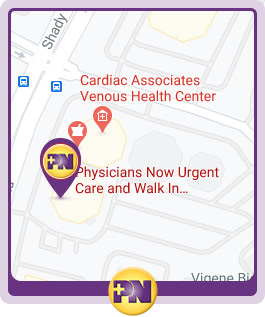Work Injuries Services at Physicians Now Urgent Care in Rockville, MD
Physicians Now Urgent Care offers work injuries services. Call now, walk in, or reserve your spot online! We are located at 15215 Shady Grove Road, Suite 100, Rockville, MD 20850. Open Monday-Friday 8a.m.-6p.m. and Saturday & Sunday 9a.m.-5p.m.


Table of Contents:
Types of injuries
Repetitive stress injuries
Diagnosing injuries
No matter where you’re employed, the risk of work injuries is always present. Something as simple as a fall or a slip can lead to fractures, broken bones or other serious injuries and prevent you from going back to work. Whether you are looking for treatment or want to get a second opinion because you are considering litigation, our urgent care in Rockville, MD can help you determine the extent of your injury.
According to the Washington State Dept. of Labor & Industries, there are seven common types of workplace injuries:
• Getting caught in machinery
• Falls from high places or ladders
• Slips and falls while on ground level
• Impacts and getting struck by objects
• Traffic accidents (common among delivery and truck drivers)
• Knees and ankles injuries (especially among workers who have to lift heavy weights or regularly crouch and stand)
• Repetitive injuries of the neck, shoulders and back
The Washington State Dept. of Labor & Industries also points out that certain jobs are more likely to cause injuries, with construction and trucking leading the list for the number of workplace injuries reported each year.
Other professions, such as police officers, nurses and firefighters, are more likely to suffer fatal or very serious injuries, but not as likely to receive injuries that fall in the list above.
Certain jobs have a high incidence of repetitive stress injuries. In fact, any job that requires a single movement to be repeated over and over can lead to injuries, as the body wears down from the repetition.
A common example of this is jobs that require you to sit at the computer for long periods of time, which can result in carpal tunnel syndrome and other injuries of the elbow, shoulders and wrists.
One less known type of repetitive stress injury or disorder (RSD) affects workers that stay in a specific position for long hours. This includes sitting, standing or crouching. Assembly line workers often suffer from this type of injury. People who stock shelves, work in packing companies, work in pipe setting and even mechanics have to deal with these injuries as well. Anything that requires overhead work is especially damaging to the spine, neck and shoulders and often results in injury.
Because workplace injuries can be so varied, it’s difficult to say what kind of tests you will need to evaluate yours. Major injuries might be easier to diagnose and treat because a provider can quickly determine what’s wrong and can start dealing with it.
For minor injuries or those that are not obvious at first view, your provider might order a series of tests, starting with x-rays. You might also need to see a physical therapist or another specialist to determine the wear and tear of the area and see what can be done to repair the problem. A number of musculoskeletal disorders, such as those created by heavy lifting, often lead to pain but don’t show up easily in x-rays . In that case, your provider might need to do a manual evaluation, looking into range of motion, strength and response to pain to determine the type of injury.
The treatment of injuries depends on how you got hurt and how extensive the injury is. Physical therapy is a common recommendation, and you might need to take time off work to allow the body to heal and the inflammation to subside. In the case of repetitive stress injuries, you might need to wear a protective device, such as a waist or wrist support to prevent the injury from reoccurring after treatment.

Additional Services You May Need
▸Illness
▸Injuries
▸Acute Care
▸Asthma
▸Head Injury
▸Cholesterol Management
▸Diabetes
▸Flu Shot
▸Heart Disease
▸RSV Testing

Additional Services You May Need
▸Illness
▸Injuries
▸Acute Care
▸Asthma
▸Head Injury
▸Cholesterol Management
▸Diabetes
▸Flu Shot
▸Heart Disease
▸RSV Testing







